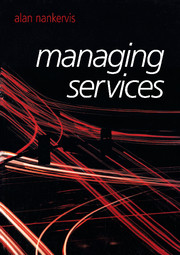Book contents
- Frontmatter
- Contents
- Figures and tables
- Contributors
- Preface
- Acknowledgements
- 1 Services and their management
- 2 The services environment
- 3 Stakeholders and their influence on services
- 4 Managing strategy in services
- 5 Marketing management in services
- 6 Strategic operations management in services
- 7 Financial management in services
- 8 Human resource management in services
- 9 From managing ‘service’ to integrated services management
- Index
- References
4 - Managing strategy in services
Published online by Cambridge University Press: 22 September 2009
- Frontmatter
- Contents
- Figures and tables
- Contributors
- Preface
- Acknowledgements
- 1 Services and their management
- 2 The services environment
- 3 Stakeholders and their influence on services
- 4 Managing strategy in services
- 5 Marketing management in services
- 6 Strategic operations management in services
- 7 Financial management in services
- 8 Human resource management in services
- 9 From managing ‘service’ to integrated services management
- Index
- References
Summary
Learning objectives
After studying this chapter, readers will be able to:
distinguish between traditional approaches to strategy and more recent strategic management models
appreciate the conceptual logic underpinning strategic management models
grasp the relationship between an integrated strategic management perspective and the management of the practical operational, financial, marketing and human resource management aspects of service
explore and explain the blurring of the traditional boundaries between goods and services
understand why a more comprehensive and integrated approach to strategic management is now required in order to design and sustain competitive advantage towards service
analyse a selection of specific service case examples from a strategic management perspective.
Introduction
The previous chapters explored the growing importance and distinctive characteristics of service and the various challenges involved in managing it. They analysed the global, regional, national and local environments within which service is provided, and discussed the complex and dynamic nature of stakeholder management issues that now impact upon organisations as they place greater emphasis upon service. This chapter focuses on the conceptual aspects and practical implementation implications of a strategic management approach to service. In doing so, it also discusses the critical importance of taking a strategic management perspective in applying the integrated services management model. The ideas presented in this chapter provide a foundation for the subsequent chapters, which in turn analyse the specific issues associated with the marketing, operational, financial, and HR management (HRM) dimensions of the ISM.
- Type
- Chapter
- Information
- Managing Services , pp. 108 - 154Publisher: Cambridge University PressPrint publication year: 2005



